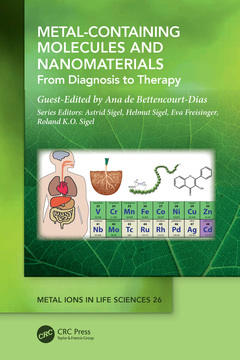Metal-Containing Molecules and Nanomaterials From Diagnosis to Therapy Metal Ions in Life Sciences Series
Coordonnateur : Bettencourt-Dias Ana de

Since the discovery and successful deployment of salvarsan to treat syphilis, as well as cisplatin as a cancer drug, the field of metallodrugs has been flourishing. In addition to therapeutic applications, metals and metal-containing molecules have properties, such as an electrochemical or an optical signal, used to diagnose biologically relevant molecules or unravel cellular metabolism. Metals are part of the essential elements for life, and of increased attention in nutraceuticals. Most of the current diagnosis processes, therapeutics and nutraceuticals are based on organic molecules. MILS-26 reviews the most recent metal-containing molecules and nanomaterials for diagnosis and therapy.
Features:
- The field of metallodrugs has been flourishing and this areas of research can be used to diagnose specific biologically relevant molecules or unravel cellular metabolism.
- Discusses the properties and therapeutic applications of metals and metal-containing molecules including an electrochemical or optical signal for diagnosis of biologically relevant molecules.
- Endorses and stimulates research in the vibrant field of biological inorganic chemistry.
- Reviews the most current research supporting the relevance of metal-containing molecules and nanomaterials for diagnosis and therapy.
- The authors are preeminent bioinorganic and medicinal inorganic chemists and review the most current research in this field.
Chapter 1 Electrochemical sensors with inorganic redox mediators
Mario A. Alpuche-Aviles
Chapter 2 Recent Advances of Medicinal Properties of Vanadium Compounds: Cancer and Other Diseases
Kateryna Kostenkova, Kameron Klugh, Debbie C. Crans
Chapter 3 Ruthenium-phthalocyanine compounds as prototypes for Photodynamic Therapy
Amanda Blanque Becceneri, Matheus Torelli Martin, Francisco Rinaldi Neto, Peter C. Ford and Roberto Santana da Silva
Chapter 4 Metal Complexes as Probes and Inhibitors of Metabolic Enzymes
Madeline Denison, Claudia Turro and Jeremy J. Kodanko
Chapter 5 Heme-Based Therapeutics
Elmira Alipour, Mark T. Gladwin, and Daniel B. Kim-Shapiro
Chapter 6 Metal-containing and metal-associated dietary nutrients
Rebeca L. Fernandez, Vanessa J. Lee, Marie C. Heffern
Chapter 7 Why is Gadolinium Still Preferred in Contrast Agents for MRI?
Mauro Botta & Mark Woods
Ana de Bettencourt-Dias received her ‘licenciatura’ (MS equivalent) in Technological Chemistry from the University of Lisbon in 1993, and her ‘Dr. rer. nat.’ (PhD equivalent) in Inorganic Chemistry from the University of Cologne in 1997 with Prof. Thomas Kruck. In her graduate work, she isolated new titanium complexes as single source precursors for the chemical vapor deposition of TiN thin layers. She joined the group of Prof. Alan Balch at UC Davis in 1998 as a Gulbenkian postdoctoral fellow, where she studied the electrochemistry and structure of fullerenes and endohedral fullerenes.
Date de parution : 07-2024
15.2x22.9 cm



